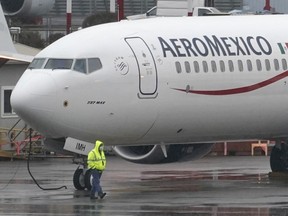
Article content
Safety experts recommended Wednesday that the engines on Boeing’s troubled 737 Max airplanes and some Airbus models be modified quickly to prevent smoke from filling the cockpit or cabin after a safety feature is activated following a bird strike.
THIS CONTENT IS RESERVED FOR SUBSCRIBERS ONLY
Subscribe now to read the latest news in your city and across Canada.
- Exclusive articles from Barbara Shecter, Joe O'Connor, Gabriel Friedman, and others.
- Daily content from Financial Times, the world's leading global business publication.
- Unlimited online access to read articles from Financial Post, National Post and 15 news sites across Canada with one account.
- National Post ePaper, an electronic replica of the print edition to view on any device, share and comment on.
- Daily puzzles, including the New York Times Crossword.
SUBSCRIBE TO UNLOCK MORE ARTICLES
Subscribe now to read the latest news in your city and across Canada.
- Exclusive articles from Barbara Shecter, Joe O'Connor, Gabriel Friedman and others.
- Daily content from Financial Times, the world's leading global business publication.
- Unlimited online access to read articles from Financial Post, National Post and 15 news sites across Canada with one account.
- National Post ePaper, an electronic replica of the print edition to view on any device, share and comment on.
- Daily puzzles, including the New York Times Crossword.
REGISTER / SIGN IN TO UNLOCK MORE ARTICLES
Create an account or sign in to continue with your reading experience.
- Access articles from across Canada with one account.
- Share your thoughts and join the conversation in the comments.
- Enjoy additional articles per month.
- Get email updates from your favourite authors.
THIS ARTICLE IS FREE TO READ REGISTER TO UNLOCK.
Create an account or sign in to continue with your reading experience.
- Access articles from across Canada with one account
- Share your thoughts and join the conversation in the comments
- Enjoy additional articles per month
- Get email updates from your favourite authors
Sign In or Create an Account
or
Article content
The problem detailed by the National Transportation Safety Board emerged after two bird strikes involving Southwest Airlines planes in 2023 — one in Havana, Cuba, and another in New Orleans. The Federal Aviation Administration and Boeing already warned airlines and pilots about the problem and the engine maker has been working on a fix.
Article content
Article content
Article content
The NTSB said that the engines CFM International makes for the Boeing plane can inadvertently release oil into the hot engine when the safety feature, called a load reduction device, is activated after a bird strike or similar engine issue. The resulting smoke feeds directly into either the cockpit or passenger cabin depending on which engine was struck.
Article content
By signing up you consent to receive the above newsletter from Postmedia Network Inc.
Article content
Air from the left engine on a 737 Max flows directly into the cockpit while air from the right engine flows into the passenger cabin.
Article content
The NTSB investigated a December 2023 incident in which a Southwest Airlines plane struck a bird while taking off from New Orleans and had to land quickly after thick smoke filled the cockpit _ even making it hard for the pilot to see the instrument panel.
Article content
In an incident nine months earlier involving another Southwest 737 Max, smoke filled the cabin after a bird strike after takeoff in Havana.
Article content
While these incidents were both bird strikes, the NTSB said this could happen in certain other circumstances.
Article content
The FAA said in a statement that it agrees with the NTSB recommendations and when “the engine manufacturer develops a permanent mitigation, we will require operators to implement it within an appropriate timeframe.”
Article content
Article content
Pilots can act to limit smoke in the plane by manually cutting off airflow from the engines, but smoke can quickly start to fill the cabin within a few seconds. The engine manufacturer is working on a software update that should do that automatically, but that’s not expected to be ready until sometime in the first quarter of next year.
Article content
Boeing and Airbus didn’t immediately respond to requests for comment.
Article content
A Southwest spokesperson said the airline has been in close contact with the FAA, Boeing and the engine maker since the incidents and notified its pilots after they happened. The spokesperson said the airline continues to address the issue through its training and safety management systems.
Article content
The NTSB urged European aviation safety regulators to evaluate different models of these engines that are used to determine if they could also be susceptible to this smoke problem.
Article content
Although the NTSB said these engines are used on some Airbus A320neo planes, the Boeing 737 Max planes have been the focus since they were involved in both incidents, and there has been a history of other problems with that plane.

.jpg) 3 hours ago
1
3 hours ago
1
 English (US)
English (US)